Dragunov sniper rifle
The Dragunov sniper rifle (formal Russian: Сна́йперская Винто́вка систе́мы Драгуно́ва образца́ 1963 года, Snáyperskaya Vintóvka sistém'y Dragunóva obraz'tsá 1963 goda (SVD-63), officially "Sniper Rifle, System of Dragunov, Model of the Year 1963") is a semi-automatic sniper/designated marksman rifle chambered in 7.62×54mmR and developed in the Soviet Union.
| SVD-63 | |
|---|---|
.jpg) Russian-made SVD (top) and SVDS (shortened variant with folding stock) rifles featuring modern synthetic furniture | |
| Type | Semi-automatic sniper rifle, designated marksman rifle |
| Place of origin | Soviet Union |
| Service history | |
| In service | 1963-present |
| Used by | See Users |
| Wars |
|
| Production history | |
| Designer | Yevgeny Dragunov |
| Designed | 1958–1963 |
| Manufacturer | |
| Produced | 1963–present[10] |
| Variants | See Variants |
| Specifications | |
| Mass |
|
| Length |
|
| Barrel length |
|
| Cartridge | 7.62×54mmR[10] |
| Action | Gas-operated, rotating bolt |
| Rate of fire | 30 RPM |
| Muzzle velocity |
|
| Effective firing range | 800 m (875 yd) |
| Feed system | 10-round detachable box magazine[10] |
| Sights | PSO-1 telescopic sight, 1PN51/1PN58 night vision sights and iron sights with an adjustable rear notch sight |
The Dragunov was designed as a squad support weapon since, according to Soviet and Soviet-derived military doctrines, the long-range engagement ability was lost to ordinary troops when submachine guns and assault rifles (which are optimized for close-range and medium-range, rapid-fire combat) were adopted.
It was developed in 1957–1963 and selected as the winner of a contest that included three competing groups of designers: led by Sergei Simonov, Aleksandr Konstantinov and Yevgeny Dragunov. Extensive field testing of the rifles conducted in a wide range of environmental conditions resulted in Dragunov's proposal being accepted into service on 3 July 1963. An initial pre-production batch consisting of 200 rifles was assembled for evaluation purposes, and from 1964 serial production was carried out by Izhmash, later called Kalashnikov Concern.
Since then, the Dragunov has become the standard squad support weapon of several countries, including those of the former Warsaw Pact. China produced an unlicensed copy of the SVD through reverse-engineered samples captured during the Sino-Vietnamese War as the Type 79 and 85.[11] Iran also produced a clone, the Nakhjir 3, which was a direct copy of the Chinese Type 79.
Design details
Operating mechanism
The Dragunov is a semi-automatic, gas-operated rifle with a short-stroke gas-piston system. The barrel breech is locked through a rotating bolt (left rotation) and uses three locking lugs to engage corresponding locking recesses in the barrel extension. The rifle has a manual, two-position gas regulator. A gas regulator meters the portion of the combustion gases fed into the action in order to cycle the weapon and sets the recoil velocity of the gas-piston system. The gas regulator can be set with the help of the rim of a cartridge. The normal position #1 leaves a gas escape port opened in the form of a hole that lets some combustion gas escape during cycling. Position #2 closes the gas escape port and directs extra combustion gas to the piston increasing the recoil velocity of the gas-piston system and felt recoil. It is used for when the rifle does not reliably cycle due to carbon fouling build-up in the gas port, when shooting in extreme cold or high altitude or using low-powered ammunition.
After discharging the last cartridge from the magazine, the bolt carrier and bolt are held back on a bolt catch that is released by pulling the cocking handle to the rear. The rifle has a hammer-type striking mechanism and a manual lever safety selector. The firing pin is a "free-floating" type and, as a result, some soft-primered ammunition had the reputation of causing a "slam fire" event. Thus, military-grade ammunition with primers confirmed to be properly seated is recommended for the Dragunov and its variants. This appears to have solved the "slam fire" issue. The rifle's receiver is machined to provide additional accuracy and torsional strength. The Dragunov's receiver bears a number of similarities to the AK action, such as the large dust cover, iron sights and lever safety selector, but these similarities are primarily cosmetic in nature, because the Dragunov uses a short-stroke action as opposed to the long-stroke operating mechanism of the AK. These cosmetic similarities can lead to mis-categorization of the Dragunov as an AK variant.
Barrel
The barrel profile is relatively thin to save weight. Its bore is chrome-lined for increased corrosion resistance, and features 4 right-hand grooves. In the 1960s, the twist rate was 320 mm (1:12.6 in). During the 1970s, the twist rate was increased to 240 mm (1:9.4 in), which reduced the accuracy of fire with sniper cartridges by 19%. This adaptation was done in order to facilitate the use of tracer and armor-piercing incendiary ammunition, since these bullet types required a faster twist rate for adequate stabilization.[12] The muzzle is equipped with a permanently affixed long slotted flash hider, front sight and bayonet lug which is pinned to the end of the barrel.
Ammunition feeding
The rifle is fed from a detachable curved box magazine with a 10-round capacity and the cartridges are double-stacked in a staggered zigzag pattern.
Sights

The rifle features mechanically adjustable backup iron sights with a sliding tangent rear sight (the iron sight line can be adjusted from 100 to 1,200 m (109 to 1,312 yd) in 100 m (109 yd) increments). The iron sights can be used with or without the standard issue optical sight in place. This is possible because the scope mount does not block the area between the front and rear sights.
The Dragunov is issued with a quick-detachable PSO-1 optical sight.[13] The PSO-1 sight (at a total length of 375 mm with a lens cover and sun shade, 4 × magnification and 6° field of view) mounts to a proprietary side mount Warsaw Pact rail that does not block the view of the iron sight line. The PSO-1 sight includes a variety of features, such as a bullet drop compensation (BDC) elevation adjustment knob and an illuminated rangefinder grid that can be used up to 1,000 m (1,094 yd), a reticle that enables target acquisition in low light conditions as well as an infrared charging screen that is used as a passive detection system. The current version of the sight is the PSO-1M2. This telescopic sight is different from the original PSO-1 only in that it lacks the now obsolete Infra-Red detector. The PSO-1 sight enables area targets to be engaged at ranges upwards of 1,300 m (1,422 yd); effective ranges in combat situations have been stated at between 600 to 1,300 m (656 to 1,422 yd), depending on the nature of the target (point or area target) quality of ammunition and skill of the shooter.[6][14]
Several military issue alternative telescopic sights with varying levels of magnification and reticles are available for the Dragunov. Rifles designated SVDN come equipped with a night sight, such as the NSP-3, NSPU, PGN-1, NSPUM or the Polish passive PCS-5. Rifles designated SVDN-1 can use the passive night sight NSPU-3 (1PN51)[15] and rifles designated SVDN2 can use the passive night sight NSPUM (1PN58).[16]
Commercial non military issue mounts that attach to the Warsaw Pact rail mount allow use of Picatinny rail-based aiming optics.[17]
Stock
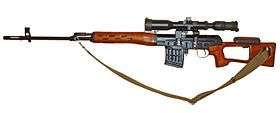
The Dragunov has a vented, two-piece wooden handguard/gas tube cover and a skeletonized wooden thumbhole stock equipped with a detachable cheek rest; the latter is removed when using iron sights. Newer production models feature synthetic furniture made of a black polymer – the handguard and gas tube cover are more or less identical in appearance, while the thumbhole stock is of a different shape.
The barrel is semi free-floated, since it is connected by a spring-loaded mechanism to the handguard/gas tube cover so the handguard can move with the barrel during firing.
Ammunition
For precision shooting, specifically designed sniper cartridges are used, developed by V. M. Sabelnikov, P. P. Sazonov and V. M. Dvorianinov. The proprietary 7N1 load has a steel jacketed projectile with an air pocket, a steel core and a lead knocker in the base for maximum terminal effect. The 7N1 was replaced in 1999 by the 7N14 round. The 7N14 is a new load developed for the SVD. It consists of a 151 grain projectile that travels at the same 830 m/s, but it has a sharp hardened steel core projectile. The rifle can also fire standard 7.62×54mmR ammunition with either conventional, tracer or armor-piercing incendiary rounds.
The Russian military has established accuracy standards that the SVD and its corresponding sniper grade ammunition have to meet. Manufacturers must perform firing tests to check if the rifles and sniper grade ammunition fulfill these standards. To comply to the standards, the SVD rifle with 7N1 sniper cartridges may not produce more than 1.24 MOA extreme vertical spread with 240 mm twist rate barrels and no more than 1.04 MOA extreme vertical spread with 320 mm twist rate barrels. When using standard grade 57-N-323S cartridges, the accuracy of the SVD is reduced to 2.21 MOA extreme vertical spread. The extreme vertical spreads for the SVD are established by shooting 5-shot groups at 300 m range. The accuracy requirements demanded of the SVD with sniper grade ammunition are similar to the American M24 Sniper Weapon System with M118SB cartridges (1.18 MOA extreme vertical spread) and the M110 Semi-Automatic Sniper System with M118LR ammunition (1.27 MOA extreme vertical spread).
Accessories

A number of accessories are provided with the rifle, including a blade-type bayonet (AKM clipped point or the AK-74 spear point bayonet), four spare magazines, a leather or nylon sling, magazine pouch, cleaning kit and an accessory/maintenance kit for the telescopic sight. Also included is a cold weather battery case with a "shirt clip", with a permanently attached cord [approximately 24" long] ending with another battery case cap that has an extension to press against the internal contact in lieu of the battery to complete the circuit. Placing the external battery case into the shooters' clothing close to the body keeps it from freezing; using the clip ensures it remains in place. The clamp-style bipod attaches to machined-out reliefs near the front of the receiver, it literally grabs the two cut out areas and securely mounts with a large round sized head on the clamp bolt able to tightly attach the bipod. The legs are individually adjustable [as opposed to fixed length found on many rifles and LMG's] and can be folded and stowed in a forward position negating the need to remove the bipod before placing the rifle into the canvas carrying case. The two legs are held close together with a "J" shaped clamp attached to one leg and swung over the other leg. Original Soviet/Russian SVD bipods fetch a very high price when they rarely appear on the market.
Variants
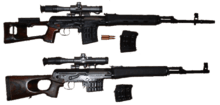


In the early 1990s, a compact variant of the SVD designed for airborne infantry was introduced, known as the SVDS (Russian: снайперская винтовка Драгунова складная, short for Snayperskaya Vintovka Dragunova Skladnaya, "Dragunov Sniper Rifle with folding stock"), which features a tubular metal stock that folds to the right side of the receiver (equipped with a synthetic shoulder pad and a fixed cheek riser) and a synthetic pistol grip. The barrel was also given a heavier profile, the receiver housing was strengthened, the gas cylinder block was improved and a ported, shorter conical flash suppressor was adopted.
The SVDS also comes in a night-capable variant designated SVDSN.
In 1994, the Russian TsKIB SOO company (currently, a division of the KBP Instrument Design Bureau) developed the SVU sniper rifle (short for Snayperskaya Vintovka Ukorochennaya, "Sniper Rifle, Shortened") offered to special units of the Russian Ministry of Internal Affairs (MVD).
The SVU, compared to the SVD, has a considerably shorter overall length because of the bullpup layout and shortened barrel that also received a triple-baffle muzzle brake with an approx. 40% recoil reduction effectiveness. The rifle was equipped with folding iron sights (rear aperture sight in a rotating drum) and the PSO-1 telescopic sight.
A variant of the SVU, designed with a selective-fire capability and using 20-round magazines, is called the SVU-A (A – Avtomaticheskaya).
The SVDK is a Russian SVD variant chambered for the 9.3×64mm 7N33 cartridge. The SVDK is mechanically adapted to use dimensionally larger 9.3×64mm Brenneke cartridges.
An improved 7.62×54mmR version designated as SVDM entered service in June 2018.[18] It is based on the SVDS, featuring a thicker and heavier 550 mm (21.7 in) long barrel, improved ergonomics, an adjustable side-folding shoulder stock, and an integrated length of Picatinny rail pinned to the redesigned top cover. This allows mounting various sighting optics. The variable power 1P88-4 (1П88-4) telescopic sight is used as the standard day optic. The SVDM rifle can be used with a detachable bipod, and with a quick-detachable suppressor. The iron sight line features a simplified rear sight element and a new front sight element located above the gas block. The SVDM has a length of 1,135 mm (44.7 in) (975 mm (38.4 in) with the stock folded) and weighs 5.3 kg (12 lb).[19]
In 1998, Poland adopted a modernized variant of the SVD designated the SWD-M, which uses a heavy barrel, bipod (mounted to the forearm) and LD-6 (6×42) telescopic sight.
Another variant of the SVD is the Iraqi Al-Kadesih. The 7.62×54mmR Al-Kadesih rifle is not to be confused with the Iraqi 7.62×39mm Tabuk sniper rifle.[20] The Al-Kadesih, while cosmetically similar to the SVD, is essentially a hybrid of the SVD and Romanian PSL rifles and has some key differences with the SVD that prevent parts interchangeability between the two rifles. The Al-Kadesih has a unique pressed-metal receiver which is longer than that of the SVD, although the overall length of the rifle is similar to that of the SVD. It is fitted for the Soviet-era PSO-1 optical sight. Further, the barrel is pinned, rather than screwed, to the receiver, although it is of the same length as that of the SVD. The fore-end has four longitudinal slots on each side instead of six short slots. Another readily visible distinguishing feature of the Al-Kadesih is that the magazine has an ornamental relief pattern showing a stylised palm tree.[21][22]
Commercial variants
The Dragunov also served as the basis for several hunting rifles. In 1962, the state armory in Izhevsk developed the Medved (Bear) rifle, initially chambered first in the 9×53mm cartridge and later in the 7.62×51mm NATO round for export. In the early 1970s, Izhevsk introduced the Tigr (Tiger) hunting rifle with a fixed thumbhole stock without a cheekpiece. They were originally produced individually, but, since 1992, they have been made serially in batches. Today, they are available with shortened (520 mm) and full length (620 mm) barrel, different stocks (including SVDS style folding stock) and chambered in 7.62×54mmR, .308 Winchester, .30-06 Springfield or 9.3×64mm Brenneke.
Deployment
The Dragunov is an original rifle design for several reasons. First, it was not meant for highly trained and specialized sniper teams, but rather for designated marksmen. After the introduction of the SVD, the Soviet Army deployed designated marksmen at the basic motorized infantry rifle platoon level.[23] Those designated marksmen were often chosen from personnel who did well in terms of rifle marksmanship while members of DOSAAF. Such marksmen were estimated to have a 50% probability of hitting a standing, man-sized target at 800 m (875 yd), and an 80% probability of hitting a standing, man-sized target at 500 m (547 yd). For distances not exceeding 200 m (219 yd) the probability was estimated to be well above 90%. To attain this level of accuracy the sniper could not engage more than two such targets per minute.[24]
Once the rifle had been produced in sufficient numbers every platoon of Warsaw Pact troops included at least one Dragunov rifle marksman. In the German Democratic Republic arsenals alone, there were almost 2,000 Dragunov rifles.[25] In Warsaw Pact troop formations, the Dragunov marksmen were widespread among the regular units. To fulfill this role, the SVD is relatively light for a sniper rifle, but well balanced, making it easier to use in a dynamic battle. It is also semi-automatic, a trait it shares with the German Heckler & Koch PSG1 and US M21, so as to allow rapid fire and quicker engagement of multiple targets. As with all precision-oriented rifles, the user has to take care not to overheat the barrel and limit the use of rapid fire. In order to fire effective Armor-piercing incendiary (API) ammunition, its accuracy potential was slightly downgraded by shortening the twist rate, another uncommon priority for a pure sniper rifle. It has a relatively light barrel profile; its precision is good, but not exceptional. Like an infantry rifle, there are mounts on the barrel to fix a bayonet. The standard AKM bayonet can even be used to cut electrified barbed wire. Lastly, the rifle was meant to be a relatively cheap mass-produced firearm.
These features and unusual characteristics were driven by the tactical use doctrine of Dragunov armed marksmen, which was: from (just behind) the first line targeting high-value targets of opportunity and providing special long-distance disrupting and suppressive fire on the battlefield, even with sudden close encounters with enemy troops in mind. A relatively small number of marksmen could assist conventional troops by combating or harassing valuable targets and assets such as key enemy personnel like officers, non-commissioned officers and radio operators, exposed tank commanders, designated marksmen and snipers, machinegun teams, anti-tank warfare teams, etc.[26]
Users






















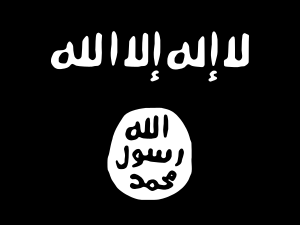

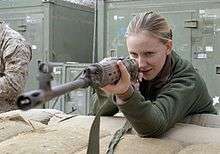 A U.S. Marine sights a Dragunov SVDS sniper rifle which was captured during the Iraq War.
A U.S. Marine sights a Dragunov SVDS sniper rifle which was captured during the Iraq War.













- Provisional Irish Republican Army: supplied from Libya[72]








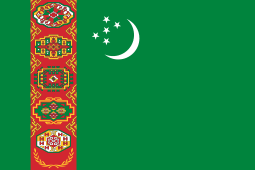





Former users


See also
- SVDK a variant of the SVD, chambered in 9.3×64mm Brenneke.
- VSS Vintorez, a suppressed sniper rifle also used in limited numbers in Russia, similar weapon.
- Puşca Semiautomată cu Lunetă (PSL), a Romanian designated marksman/sniper rifle that resembles the SVD, chambered in 7.62×54mmR.
- Zastava M76, a Yugoslavian designated marksman/sniper rifle that resembles the SVD, chambered in 7.92×57mm Mauser.
- Zastava M91, a Serbian designated marksman/sniper rifle that resembles the SVD, chambered in 7.62×54mmR.
- Galil Sniper, an Israeli designated marksman/sniper rifle that resembles the SVD, chambered in 7.62×51mm NATO.
References
- "Weapons corner: sniper rifles then and now". Infantry Magazine. 2006. Archived from the original on 2010-05-29. Retrieved 2010-04-16.
- "Archived copy". Archived from the original on 2013-02-11. Retrieved 2016-12-18.CS1 maint: archived copy as title (link)
- Campbell, David (30 Nov 2017). Soviet Paratrooper vs Mujahideen Fighter: Afghanistan 1979–89. Combat 29. Osprey Publishing. pp. 14–15. ISBN 9781472817648.
- Մարտական գործողություն` նկարահանված Հայաստանի և Ադրբեջանի կողմից [Military action made by Armenia and Azerbaijan] (in Azerbaijani, Armenian, and Russian). Azerbaijan. c. 1990. Event occurs at 9:03. Archived from the original on 9 September 2015. Retrieved 15 Jun 2015.
- Neville 2016, p. 192.
- "snipersparadise.com discussion on the SVD effective range by sniper instructors/users". Archived from the original on 17 October 2016. Retrieved 13 November 2014.
- Touchard, Laurent (18 June 2013). "Armée malienne : le difficile inventaire". Jeune Afrique (in French). Archived from the original on 8 April 2019. Retrieved 24 September 2018.
- "Archived copy". Archived from the original on 2014-04-11. Retrieved 2017-06-09.CS1 maint: archived copy as title (link)
- Yemen War 2015 - Heavy Clashes On The Saudi Border As Houthi Rebels Attack Saudi Military Outposts (in Arabic). Yemen. 2015. Event occurs at 9:46. Archived from the original on 12 August 2015. Retrieved 19 June 2015.
- Hogg, Ian (2002). Jane's Guns Recognition Guide. Jane's Information Group. ISBN 0-00-712760-X.
- "Archived copy". Archived from the original on 2019-04-03. Retrieved 2019-04-03.CS1 maint: archived copy as title (link)
- Evgeniy Dragunov: Creator of Firepower (abstracts from a forthcoming book) Archived 2009-02-27 at the Wayback Machine
- "PSO-1 Manual" (PDF). AR15.com. Archived from the original (PDF) on May 18, 2011. Retrieved October 29, 2007.
- "UN judgement dealing with sniping during the Yugoslav wars" (PDF). Archived from the original (PDF) on 5 February 2009. Retrieved 13 November 2014.
- ИЗДЕЛИЕ 1ПН51 ТЕХНИЧЕСКОЕ ОПИСАНИЕ И ИНСТРУКЦИЯ ПО ЭКСПЛУАТАЦИИ [PRODUCT 1PN51 TECHNICAL DESCRIPTION AND OPERATING INSTRUCTIONS] (in Russian). January 1992. pp. 11, 16.
- ИЗДЕЛИЕ 1ПН58 ТЕХНИЧЕСКОЕ ОПИСАНИЕ И ИНСТРУКЦИЯ ПО ЭКСПЛУАТАЦИИ [PRODUCT 1PN58 TECHNICAL DESCRIPTION AND OPERATING INSTRUCTIONS] (in Russian). February 1991. pp. 5, 13.
- "SVDM - Dragunov Sniper Rifle Scope Mount". FAB Defense. Archived from the original on 9 September 2015. Retrieved 16 August 2015.
- "Russian Southern Military District receives upgraded large caliber rifles, automatic guns, www.armyrecognition.com. Retrieved 3 July 2018". Archived from the original on 2 July 2018. Retrieved 2 July 2018.
- "Sniper rifle SVDM, Kalashnikov Group. Retrieved 2 July 2018". Archived from the original on 2 July 2018. Retrieved 2 July 2018.
- American Rifleman, February 2010, page 59 Archived 2015-10-18 at the Wayback Machine. Retrieved 26 June 2014.
- "The Iraqi Al Kadesiah Rifle". Dragunov.net. Archived from the original on 2012-12-14. Retrieved 30 Dec 2012.
- "Iraqi Al Kadesiah (also known as Al Kadesih) Sniper Rifle 7.62×54mmR". designatedmarksman.net. Archived from the original on 2014-10-23. Retrieved 2014-06-27.
- US Army, FM 100-2-3 The Soviet Army: Troops, Organization and Equipment, 4-3
- Isby, David C. (1981). Weapons and Tactics of the Soviet Army. Jane's Information Group. ISBN 0-531-03732-0.
- "List of GDR weapons". Archived from the original on 23 September 2015. Retrieved 13 November 2014.
- Po, Enrico: Dragunov, RID Magazine June 1997 p.49-52
- Miller, David (2001). The Illustrated Directory of 20th Century Guns. Salamander Books Ltd. ISBN 1-84065-245-4.
- Neville 2016, p. 127.
- The World Defence Almanac 2006, page. 95, Mönch Publishing Group, Bonn 2006
- Bonn International Center for Conversion; Bundeswehr Verification Center. "Dragunov SVD". SALW Guide: Global distribution and visual identification. Archived from the original on 31 August 2018. Retrieved 31 August 2018.
- http://www.bdmilitary.com/index.php?option=com_content&view=article&id=215&Itemid=95%5B%5D
- Bangladesh Army Weapon Systems Handbook 1st Edition. Washington DC,USA: International Business Publications. 2011. p. 66. ISBN 1433062070.
- Jones, Richard D. Jane's Infantry Weapons 2009/2010. Jane's Information Group; 35 edition (January 27, 2009). ISBN 978-0-7106-2869-5.
- FirearmsWorld (2015-02-17). 79/85式狙击步枪 (in Chinese). firearmsworld.net. Archived from the original on 2017-07-23. Retrieved 2017-08-08.
- Small Arms Survey (2007). "Armed Violence in Burundi: Conflict and Post-Conflict Bujumbura" (PDF). The Small Arms Survey 2007: Guns and the City. Cambridge University Press. p. 204. ISBN 978-0-521-88039-8. Archived from the original on 2018-08-27. Retrieved 2018-08-29.
- Letter dated 26 June 2014 from the Panel of Experts on the Central African Republic established pursuant to Security Council resolution 2127 (2013) addressed to the President of the Security Council (PDF). 1 July 2014. p. 81. Archived (PDF) from the original on 29 March 2017. Retrieved 29 January 2019.
- Neville 2016, pp. 188-190.
- Type 79/85 Sniper Rifle. Archived 2008-09-30 at the Wayback Machine Retrieved on September 21, 2008.
- 7.62 mm SNIPPING RIFLE. Retrieved on September 29, 2008. Archived January 6, 2009, at the Wayback Machine
- NDM-86. Archived 2008-10-04 at the Wayback Machine Retrieved on September 21, 2008.
- NDM86. Archived 2009-01-06 at the Wayback Machine Retrieved on September 29, 2008.
- "Archived copy" (PDF). Archived (PDF) from the original on 2012-02-29. Retrieved 2010-02-20.CS1 maint: archived copy as title (link)
- Katz, Sam (24 Mar 1988). Arab Armies of the Middle East Wars (2). Men-at-Arms 128. Osprey Publishing. pp. 39, 42. ISBN 9780850458008.
- "The Finnish Defence Forces 7.62 TKIV Dragunov". Archived from the original on 28 April 2009. Retrieved 13 November 2014.
- Singh, Lieutenant General R.K. Jasbir. Indian Defence Yearbook. India: Natraj Publishers. pp. 388–391. ISBN 978-81-86857-11-3.
- Editorial Team. "8 Pictures Of Indian Army Sniper Team Will Give You Goosebumps". SSB Crack. Archived from the original on 2017-08-09. Retrieved 2017-08-08.
- Manu Pubby (2016-12-08). "Indian Army Looking For A Deadlier Sniper Rifle To Replace Ageing Draganov". India Times. Archived from the original on 2017-08-09. Retrieved 2017-08-08.
- "Archived copy". Defence news.in. Archived from the original on 2019-02-12. Retrieved 2019-02-10.CS1 maint: archived copy as title (link)
- "Archived copy". Archived from the original on 2011-07-17. Retrieved 2010-02-20.CS1 maint: archived copy as title (link)
- Walter, John (2006). Rifles of the World. Krause Publications. pp. 100–101. ISBN 0-89689-241-7.
- Jones, Richard (2009). Jane's Infantry Weapons 2009–2010. Jane's Information Group. p. 897. ISBN 0-7106-2869-2.
- "Iran's Army Unveils New Gear in War Game". Tasnim News Agency. 12 December 2016. Archived from the original on 13 December 2016. Retrieved 12 December 2016.
- Iraqi Al Kadesiah. Archived 2009-01-02 at the Wayback Machine Retrieved on August 26, 2008.
- "Small Arms (Infantry Weapons) used by the Anti-Coalition Insurgency" (PDF). Archived from the original (PDF) on 2008-12-09. Retrieved August 26, 2008.
- Neville 2016, p. 185.
- Neville 2016, p. 163.
- Neville 2016, p. 186.
- Puxton, Matteo (30 August 2017). "Kataib al-Imam Ali, cette puissante milice chiite qui se bat à la fois en Irak et en Syrie". France Soir (in French). Archived from the original on 4 April 2019. Retrieved 27 February 2019.
- Anders, Holger (June 2014). Identifier les sources d’approvisionnement: Les munitions de petit calibre en Côte d’Ivoire (PDF) (in French). Small Arms Survey and United Nations Operation in Côte d'Ivoire. p. 15. ISBN 978-2-940-548-05-7. Archived (PDF) from the original on 2018-10-09. Retrieved 2018-09-05.
- Neville 2016, p. 196.
- Krott, Robb (April 1999). "OMEGA'S SMALL ARMS: Latvia's Hostage Rescue Team Weaponry". Small Arms Review. Vol. 2 no. 7. Archived from the original on 2018-11-19. Retrieved 2018-11-19.
- Berman, Eric G. (March 2019). Beyond Blue Helmets: Promoting Weapons and Ammunition Management in Non-UN Peace Operations (PDF). Small Arms Survey/MPOME. p. 43.
- Small Arms Survey (2007). "Persistent Instability: Armed Violence and Insecurity in South Sudan" (PDF). The Small Arms Survey 2007: Guns and the City. Cambridge University Press. p. 325. ISBN 978-0-521-88039-8. Archived from the original on 2018-08-27. Retrieved 2018-08-29.
- Touchard, Laurent (11 June 2014). "Défense : où en sont les Forces armées maliennes ?". Jeune Afrique (in French). Archived from the original on 25 September 2018. Retrieved 24 September 2018.
- Dragunov dot net - SVD rifles in use in Europe Archived 2012-11-09 at the Wayback Machine
- Savannah de Tessières (January 2018). At the Crossroads of Sahelian Conflicts: Insecurity, Terrorism, and Arms Trafficking in Niger (PDF) (Report). Small Arms Survey. p. 58. ISBN 978-2-940548-48-4. Archived (PDF) from the original on 2018-06-12. Retrieved 2018-06-05.
- "Archived copy" (PDF). Archived (PDF) from the original on 2016-03-04. Retrieved 2015-04-04.CS1 maint: archived copy as title (link)
- Morallo, Audrey (2017-06-28). "China exploring joint military drills with Philippines vs terrorism". Philstar.net. Archived from the original on 2017-06-28. Retrieved 2017-06-28.
- http://maxdefense.blogspot.com/2017/06/armed-forces-of-philippines-receives.html?m=1
- Karabin wyborowy SWD-M - zapomniana modernizacja Archived 2015-04-29 at the Wayback Machine
- "NCBiR będzie finansowało MSBS-5,56 - Altair Agencja Lotnicza". Archived from the original on 7 October 2014. Retrieved 13 November 2014.
- Neville, Leigh (25 Aug 2016). Modern Snipers. General Military. Osprey Publishing. p. 30. ISBN 9781472815347.CS1 maint: ref=harv (link)
- Neville 2016, p. 229.
- "EFS : Formation " tireur embarqué " au profit de l'armée de l'Air sénégalaise". ecpad.fr (in French). 23 June 2016. Archived from the original on 18 June 2018. Retrieved 18 June 2018.
- "El Ejército asesora a Senegal". ejercito.mde.es (in Spanish). 28 August 2015. Archived from the original on 2 February 2018. Retrieved 18 June 2018.
- "Úvodná stránka :: Ministerstvo obrany SR". Archived from the original on 2011-07-28. Retrieved 2010-05-08.
- Scarlata, Paul (April 2011). "Military rifle cartridges of the Sudan from the Khartoum to Darfur". Shotgun News. Archived from the original on 2018-11-24. Retrieved 2018-11-24.
- "Archived copy". Archived from the original on 2017-09-09. Retrieved 2017-09-09.CS1 maint: archived copy as title (link)
- "SLAHLAR". Archived from the original on 14 December 2014. Retrieved 13 November 2014.
- Chávez’s Bid for Russian Arms Pains U.S. Archived 2017-06-26 at the Wayback Machine Retrieved on September 21, 2008.
- "Sniper Rifle in PAVN (Vietnamese)". Archived from the original on 2016-06-12. Retrieved 2016-02-20.
- Staff, Reporter (30 March 2016). "Church blames ZANU-PF for economic turmoil". The Zimbabwean. Johannesburg, Gauteng. Archived from the original on 26 February 2018. Retrieved 24 February 2018.
- Military and Paramilitary Vehicles and Weapons of East Germany
External links
| Wikimedia Commons has media related to SVD. |
- IZHMASH JSC official site: 7.62 mm Dragunov Sniper Rifle "SVD"
- IZHMASH JSC official site: 7.62 mm Dragunov Sniper Rifle with folding butt "SVDS"
- Dragunov.net Dragunov rifle information
- Designatedmarksman.net Romanian PSL and Iraqi Al Kadesiah rifle information
- Buddy Hinton Collection
- SVD with 20-round magazine
- Sniper Central
- SVD field manual
- Technical data, instructional images and diagrams of the Dragunov sniper rifle (in Russian)
- Video of operation on YouTube (in Japanese)
- Dragunov Variations: Military SVD, Izhmash Tiger, Chinese NDM-86